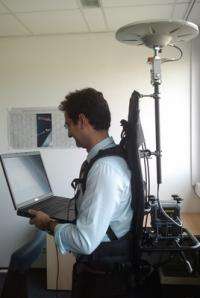High-performance ESA receiver brings satnav indoors

(�鶹��ԺOrg.com) -- Satellite navigation is having an enormous impact on our daily lives. In practical terms it means the only place left to get lost is indoors, where satnav signals fail to reach. But one ESA project is changing that.
With initial results presented at last week's Techno/Innovation Days, the DINGPOS (Demonstrator for Indoor GNSS Positioning) project combines a highly-sensitive receiver capable of picking up GPS and Galileo signals indoors with additional positioning methods.
These include accelerometer and gyroscope sensors, local WiFi-based positioning and ‘map-matching’ - associating available location data of its user in terms of a computer model of the building concerned, like a character moving through a video game.
“Global Navigation Satellite System (GNSS) signals are intended for outdoor use of course,” said David Jimenez-Baños, overseeing one of two DINGPOS contracts for ESA. “They can pass through windows and walls however - depending on the material used - though the signals are hugely attenuated. Our receiver is 10 decibels more sensitive than the best commercially available equipment, meaning it can detect GNSS signals that are 10 times weaker.”
Gustavo Lopez-Risueño, running ESA’s second DINGPOS contract, explained how it is done: “The ingredients are long integration time and computing power. A standard outdoor receiver integrates GNSS signals for just a few milliseconds, while it takes us a comparatively lengthy two seconds or even more.
"Longer integration times also require a narrower frequency resolution. Normally a standard receiver would have a resolution of hundreds of hertz, but the DINGPOS approach goes down to a single hertz. Putting these two factors together, our signal integration involves something like a million times more processing overall.”
This extreme effort is still worthwhile because Inertial Measurement Units (IMUs) integrating accelerometers and gyroscopes are prone to drift over time. Any GNSS signal that can be detected works as an absolute reference for cross-checking and correcting the user’s estimated position.

“Nowadays IMUs are mass-produced for the automobile industry but we have gone with a pedestrian-tailored design that can measure each and every step its wearer takes,” Mr Lopez-Risueño continued. “But however well it operates, an inertial system can’t do the job alone. So we also make use of whatever GNSS signals of opportunity we can acquire.
“We also plan to employ a building’s wireless network, although this requires a map of the network footprint, detailing the power required from each and every access point. It is feasible, although major calibration efforts are required. And map-matching provides an additional constraint - we can be sure the user is not going to walk through walls!”
Initially the DINGPOS system is envisaged as serving emergency services, with other applications under consideration for the longer term. A pair of consortia - one led by IFEN in Germany in partnership with UFAF, AUDENS and Telespazio and the other led by GMV in Spain and Portugal in partnership with TAS-F, UAB, ADI and Saphirion - are developing and testing separate platforms in parallel.
Testing has been taking place at the European Navigation Laboratory at ESTEC, the respective company facilities and the Galileo Test and Development Environment in Bavaria, Germany. This test facility is equipped with Galileo-like transmitters placed at high points in advance of Europe's own GNSS system becoming operational.
The DINGPOS project is supported through ESA’s Basic Technology Research Programme (TRP), and builds on previous Agency research, with both consortia exploiting technology originally patented by ESA within this field.
DINGPOS remains a proof-of-concept-project at this stage. The current platforms are bulky - reflecting the sheer density of number-crunching required - and require transport on a backpack or trolley.
That could change in future, Mr Jimenez concluded: “Our design and processing algorithms are on the cutting-edge. Right now we are continuing to test and demonstrate what can be achieved but there is no reason in principle why at some point a similar system could not be integrated into a hand-held device.”
Provided by European Space Agency



















